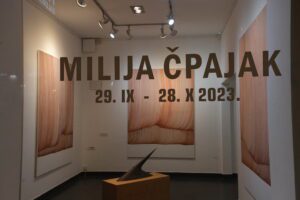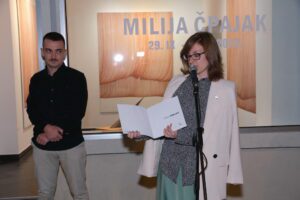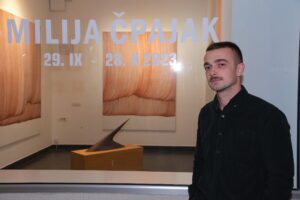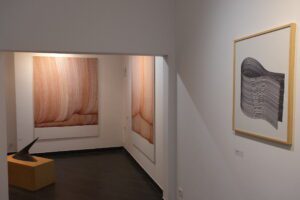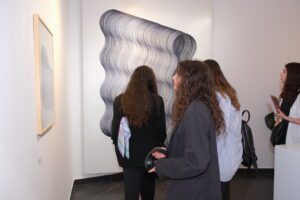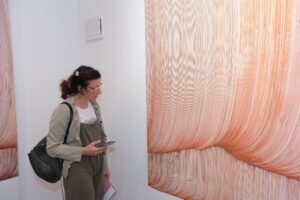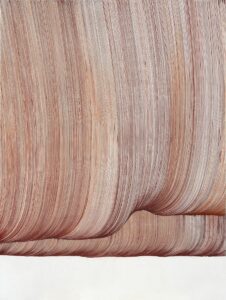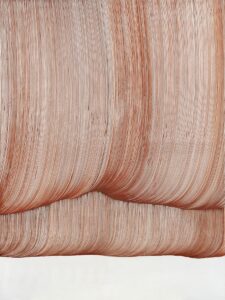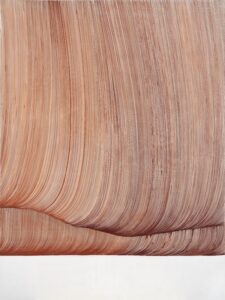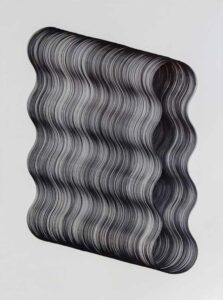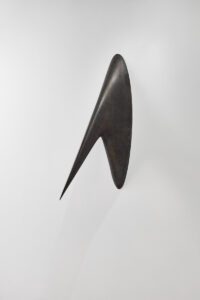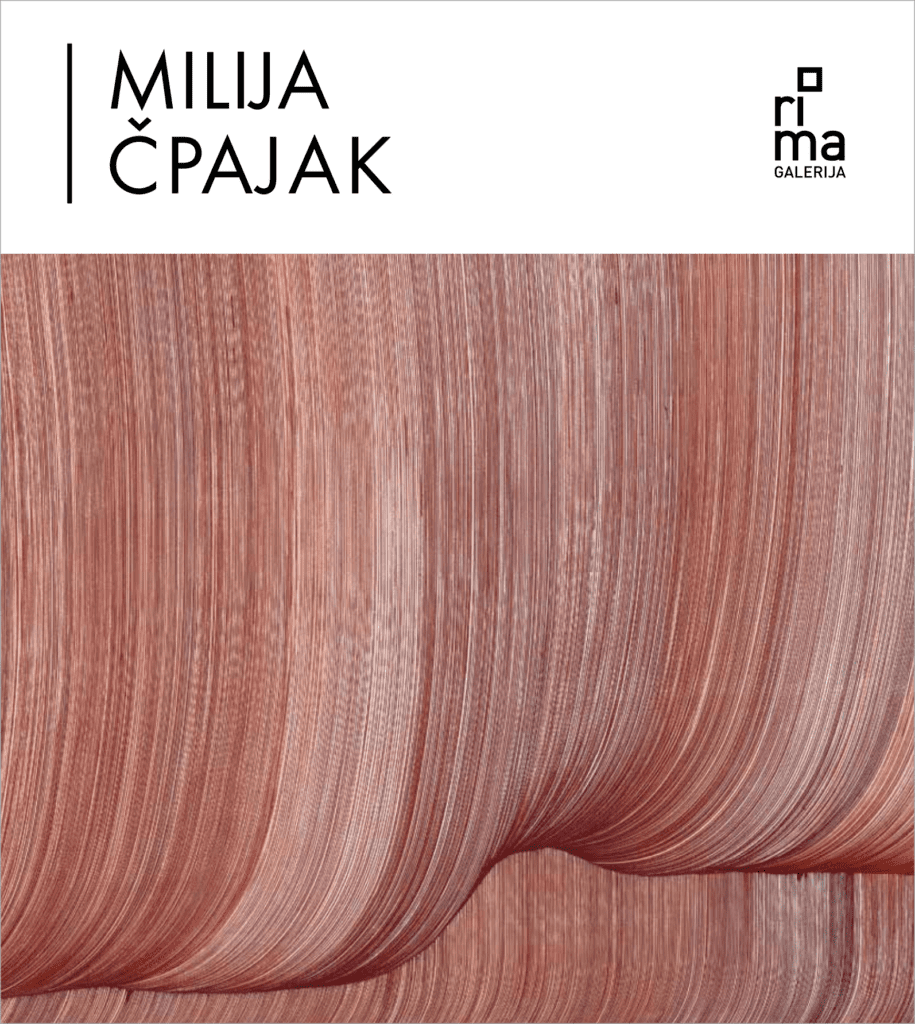Nevena Martinović
THE PAINTING OF MILIJA ČPAJAK
By carefully and studiously creating his still modest opus, Milija Čpajak, a sculptor by education, is simultaneously engaged in the area of sculpture and painting. Technically and formally diversified, sculptural works comprise different aspects of three-dimensional objects executed in ceramics, stone, bronze or even epoxy resin and concrete, with an occasional application of natural tissues such as plants, dead insects or snake skin. They could be shaped by the blow-up method (Thorn, Drop), by abstracting the form (Wasps’ Nest, Moonlight) or by the ready-made approach (Maenad, Snake Shed), Čpajak’s sculptures reflect a transparent link with nature as their fundamental departure. Anyway, the very nature of the medium of sculpture, which shares the same three-dimensional character with the physical space and which is suggestively material and tactile – mirrors an unbroken link between the artist and the realm of his inspiration. In contrast to his sculptures, Čpajak’s pictures are more distanced from the world of objects and represent the most abstract segments of his creative process. Executed in acrylic felt-pen on paper or canvas, these works stay on the borderline between a drawing and a painting – defined by clearly controlled lines, but so that the dense linear warp grows into a monumental coloured field. Čpajak’s pictures executed as drawings and represented at the exhibition in Gallery RIMA, request a new re-examination of the character of their abstraction and their place in his creative praxis.
Formally, Čpajak’s painting joins the long and diversified historic line of abstraction stemming from its use of elements of the pure painterly language, thereby nurturing their individual integrities and autonomies: with the line as the essential compound element, then the colour as the extremely simplified chromatic selection and the strictly disciplined within the linear trace (it is mostly one colour, or two nuances) and lastly, with a totally white background that underlines two-dimensionality, suggests absence of content and non-existence of illusionistic aspirations. Nevertheless, in its character, Čpajak’s abstraction is not simple, non-representational, but moderately associative. Its departure point is in the real surroundings, and its path leads from the world of objects to the world of painting. In that process of abstraction of non-painterly reality, the artist endeavours to retain recollections of distant object sources on the level of form or title. Within such general coordinates, Čpajak’s painting is defined by fine art forms which are rarely complete (Zarathustra) and most often they fluidly expand and stretch from one to another edge of the painted field – capturing the viewer on a permanent seesaw between an experience of a fully flat figure and a play of the fundamental elements of the picture (line – colour – surface) and a distant suggestion of a three-dimensional space and sculptural form.
The impression of expansion, growth, overflowing, as enhanced in his models of diptychs, triptychs and polyptychs, is the issue of artist’s focus on the process of shaping – on the creation and transformation of shapes, rather than on the final form. Even when he shows the semi-finished, seemingly three-dimensional forms, they miss the characteristics of real objects. By levitating in the white, non-representational emptiness, forms as the one in his picture Zarathustra, are devoid of corporeality and therefore their third dimension, indicated in internal shading but not anchored in mass or its position in space, appears in fact to be an illusion. Form appears as the visual trace of a wavy vibration of a uniform frequency, locked within the infiniteness of a loop. In his latest triptych – Curtain (2023) – tied to the cycle of Poem (2020) and the diptych Red Rain (2020), where a fluid red shape expands broadly and continues from one picture to another without any final borderlines – suggests an even more immediate impression of a somewhat indefinite, but vital and dynamic process that is flowing, without any visible borders. Whether it is a drapery, a “curtain of rain” or any other inspiration or possible association – the content of the picture is in fact movement and not the object. Although the artist finds seeds of his works in different phenomena from his own surroundings, primarily in nature, or, let us say, in the rain, in the wind, in flora or fauna, he does not notice a concrete object or phenomenon, but the common elements of their existence. Could Curtain suggest air movement or perhaps the conduct of fluid such as the epoxy resin the artist uses in his sculptures? It makes no difference. A totally purified application of the basic elements of a picture – thin lines, one colour and white background – indicates the bare, fundamental meaning of the presented dynamics, without any effort to define it precisely. Clusters of the lines that set the broad coloured surfaces in motion are not presentations of the striped weaving of the curtain or a water mask – those are the internal dynamic curves of the visible world. This is supported by the very title of the work – Curtain – with its purpose to shelter and hide indicates in fact that something exists behind it. In other words, Čpajak is not interested in the curtain, but the hidden entity that endows it with its identity and purpose. For that reason he does not show solid forms completely covered with pigment, but weaves them for a long time and gradually from individual lines, taking care that the internal compound structure should remain the dominant carrier of the content. This confirms again that the scholar and the artist, by means of their talent for perception and intuition can detect the same secrets of nature with an essential difference, while the first endeavours to reveal and explain the second wants to keep their invisibility and interpret the truths of nature through his artistic vision. Being together with the artist a part of the same entity of nature, we can easily recognise this fundamental dynamics, without the effort to rationalise and decode it.
Therefore, if we understand the departure points and content of Čpajak’s pictures, we can find their meaning in the character of represented movement. It is an essentially regulated and continuous movement with the integrated irregularities and periodical deviations from the given directions and trodden paths. If we take his latest works as examples, we shall be occupied by a uniform movement from the top downwards, the dynamics of a slow fall stopping in one plane, where it changes direction, broadly twists and bends backwards, leaving the impression of tense waving on the very borderline of a permanent deformation of form. Nevertheless, on the spot of the greatest tension where further changes would lead to a break or total chaos, the entity strives towards a new order and re-establishes the regular rhythm, all the way to another point of inevitable change. Čpajak achieves the same effect on the level of internal particular dynamics, drawing line after line, in a patient and lengthy movement, subtly varying the pressure on the support, in broader traces, in millimetre deviations from the path and their mutual distance, without disturbing the harmony of the integral assemblage. The delicate dynamics of irregularities, present in the whole and every individual trace, make the painted surfaces vibrate permanently, on the micro-level, with impressively bends, waves and expansion on the macro-level. Therefore these paintings associate primarily a fluid organic matter in a lively process of permanent and comprehensive change. The artist endeavours to apply to his overall opus the model of similar dynamics reflecting the integrity of a whole in the conditions of continuous internal transformation. The diversity of the media, materials, methodological approach and individual ideas make up his creative heterogeneity that can harmonise only by the common identity of Čpajak’s works – the artificial form of (abstract) ideas soaked in his experience of nature.
In using the language of painterly abstraction, Čpajak’s paintings are, as different from his sculptures, able to distance drastically from the associations centred on nature and suggest universal dynamics of the system. Not any system, but only the successful ones continuously engaged in mastering irregularities and deformations for the purpose of lasting. The moments of radical jolts and defeats – from destruction of ideological beliefs, demolition of scholarly proofs or natural catastrophes – those are the neuralgic points where it seems that the internal dynamics of the whole is strained to the limits of existence. Those are the peaks in the space of Čpajak’s picture where we feel the same sudden insecurity and nervous tension in the times of individual and collective histories. And finally, those are the identity spots of resistance, reaction and adjustment – spots and places that try the stability of every system, but also those that prove its vitality and justify its existence after the control has been re-established.
